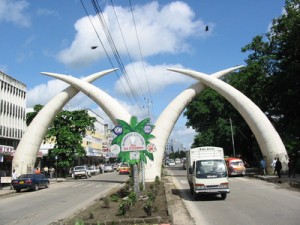Mombasa Attractions
We talk a lot about the beaches and resorts around Mombasa but now let’s take a look at some of the great attractions the city itself has to offer. Mombasa is full of culture and manmade sites worthy of more than a casual reference.
Old Town is perhaps the best known. It is a section of town located in the eastern part of Mombasa Island. If you take any road off of Digo east for a few blocks you’ll be in Old Town. It is an intricate maze of small roads cut through beautiful mosques and tall buildings (many of the white). Some of these structures date back to the early 19th century. It’s easy to get lost in this maze while exploring, so make sure you always which direction is west. Old Town isn’t that big, but it makes for a wonderful day trip.
Apart from the buildings – much of it is Swahili architecture – you will see people dressed in beautiful traditional garb. Take it slow and stop by a bakery, market, have lunch a restaurant and check out the curio shops. After 6 pm venders set up barbecue grills on the street corners and sell snacks for cheap. The street food beats most food you get in restaurants and it’s a fraction of the price.
Fort Jesus is one of the main attractions in Old Town. It was a Portuguese build in 1593. It changed hands multiple times over the next few centuries. Today it has been turned into a museum that is open from 8:30 am to 6 pm.
The impressive and symbolic Mombasa Tusks are the grand entrance to the heart of town. The tusks were built in commemoration of Queen Elizabeth’s visit in 1952. They are placed on the path from the port to the town. Ivory was considered to be a rare and precious commodity during the time, and the tusks were meant to embrace the Queen and the British Empire and welcome them into the town and its culture. Coincidentally the tusks also spell the letter “M” for Mombasa.
If you head north out of the city toward Nyali you will come across Mamba Village. This is East Africa’s largest crocodile farm. You can take an educational tour to learn about the behavior and life of these amazing reptiles. Be warned the tours end with a sometimes graphic feeding. Also of interest to nature lovers is the Bamburi Nature Trail, home to an enormous assortment of exotic flora and wildlife. On the northern coast of Mombasa, towards the town of Malindi, the Gedi Ruins are the remains of a collection of Swahili rock structures dating from the 15th century. Gedi was a small town built entirely from rocks and stones, which was inhabited by a few thousand Swahili people and ruled by a very rich Sultan. The ruins are designated as a National Museum by law, and their preservation are a direct reflection of the commitment of the Government to uphold the country’s cultural and historical background.
You can spend an entire day simply looking at the ancient mosques and temples. The dozen mosques in Old Town are the most traditional, while more modern examples in town include the Skeikh Nurein Islamic Center and the Khonzi Mosque. The Hindu Lord Shiva Temple and the Swaminarayan Temple are a few of the many symbols of Mombasa’s cultural diversity. Extravagant idols and stone carvings of the various religious ideas and gods are displayed within the temples. There is also a Sikh Temple, a Jain Temple, and a Hare Krishna Temple. The two main Christian churches are the Holy Ghost Cathedral and the Mombasa Memorial Cathedral.



 KES 14,350 PPS
KES 14,350 PPS

 KES 12,600 PPS
KES 12,600 PPS 



